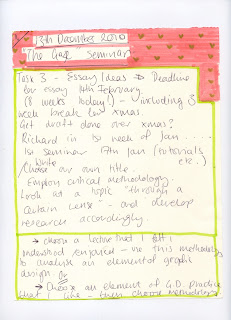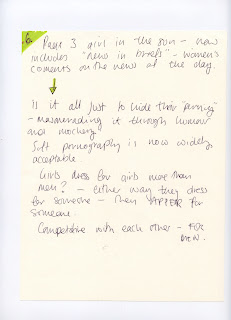Texts to look at for my essay:
Lorraine Marshment, Margaret Marshment, (1988) The Female Gaze, The Womans Press, London.
I have begun to read this book. At this stage I would say that this is my most helpful source as it deals specifically with the discussion of the active female gaze which is something that I want to investigate as a part of my essay.
Maria Elena Bussek, (2006) Pin up grrrls: Feminism, Sexuality and Popular Culture, Duke University Press, London.
I think that this book could be relevant because the pin-up is the embodiment of the sexualized idealized woman.
Whitney Chadwick, (2002) Women, Art and Society, Thames and Hudson Ltd, London.
This book offers some perpective on the position of women within society as well as within art.
Linda Nochlin, (1999), Representing women, Thames and Hudson Ltd, London.
I think that this book is relevant because I am looking at the way that women are represented in graphic design.
Laura Mulvey, (2009), Visual and other pleasures, Palgrave Macmilllan, Basingstoke.
Mulvey's essays offer some deeper information into psychoanalytic theory which is something that I need to do some more reading on.
Tony Nourmand & Graham Marsh, (2005), Exploitation Poster Art, Auram Press Ltd, London.
This book will prove to be an extremely useful source should I decide to focus on film posters as the area of graphic design that I decide to investigate.
Ideas for my essay:
-I want to centre my essay around the ideas, theorys and concepts disscussed in the essay and seminar on 'The gaze'.
-More specifically I am interested in the 'active female gaze' and graphic design in relationship to this. I am struggling to specify a particular area of graphic design to focus on, at the moment I am interested in film poster art pre-about 1970 or advertising. Obviously I need to specify this far more....
-In terms of the active female gaze; I want to investigate the concept that 'men watch women, whilst women watch themselves being watched' as well as the way that the media and the way that other women appear both act as 'mirrors' for the individual woman.
-If I am to look into advertising, I am particularly interested in the ways in which feminist ideas are utilized to sell, and how this exploitation, whether deliberate or not, could potentially be beneficial.
-I want to discuss how men and women get their dominant definitions through popular culture.
-Men dominate the prodution of nearly all of popular media, which I think is something crucial in this investigation of presentation of women in the media.
-Perhaps my ultimate question would be whether or not a female perspective can truly be produced within the mainstream.
Ideas for my essay title:
"It has been suggested that 'Men watch women, whilst women watch themselves being watched'; in a culture where men dominate the production of popluar media, is this the result of domination and pressure from men, or do woman"
"In a culture where men dominate the production of nearly all of polular culture, can a female perspective truly be produced within mainstream graphic design/advertising?"
"How has the representation of women changed in posters for film since 1970?"
Possible images to discuss within my essay:
Film posters....
'Girls on probation' film poster 1940s
directed by William McGann
'Blonde bait' film poster 1956
directed by Elmo Williams
Both these posters would be perfect for analysing the ways in which images of women were exploited prior to the women's liberation movement in 1970. I could potentially compare and contrast these images to that of some more recent films in which a woman is the protagonist, or at least feature strong, dominant female characters... (despite still using their sexuality as a weapon), such as the films of Quentin Tarrentino or Robert Rodriguez.
'Planet Terror' film promotion 2007
directed by Robert Rodriguez
'Kill Bill' film promotion 2003
directed by Quentin Tarrentino
Advertising/graphic design....
L'Oreal Glam Shine lip gloss advertising campaign fearturing Cheryl Cole
This could perhaps be used as an example of the way that images act as mirrors to other women
'The Nipple Bra'
This ad is an example of how I could investigate the way that women's products are promoted to them.
'Levi 501' ads....
This is an example of the way that mens bodies are presented within the media.
'Nuts' magazine cover
this image could be used to illustrate the way that women are presented when the audience is male.
'Elle' magazine cover
...while this image could be used to illustrate the way that women are presented when the audience is female.



























